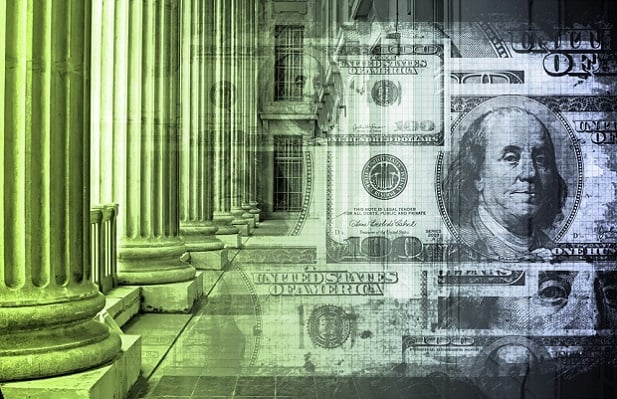Ten-year note yields reached the lowest level in a week as crude oil traded near the least in five years and risk appetite ebbed. The security's yield advantage over Group of Seven peers was almost at an eight-year high after Greek Prime Minister Antonis Samaras failed yesterday to win backing for his presidential nominee, a development that risks severing the nation's bailout accord. The yield curve, the gap between two- and 30-year yields, was at almost a six-year low.
"The safe-haven bid has been a major theme in the fourth quarter," said Adrian Miller, director of fixed-income strategies at GMP Securities in New York. "That will continue to play out as one of the catalysts that will keep the long end relatively well anchored as the front end lifts due to Fed tightening."
Recommended For You
U.S. 10-year yields fell three basis points, or 0.03 percentage point, to 2.18 percent at 10:57 a.m. New York time. They sank five basis points yesterday, the steepest decline since Dec. 16. The 2.25 percent note due in November 2024 rose 1/4, or $2.50 per $1,000 face amount, to 100 21/32.
The yield curve was at 206 basis points after reaching 201 basis points on Dec. 23, the flattest since January 2009, as the shorter-term securities fell amid speculation on a Fed rate increase. Shorter maturities are more sensitive to changes in central-bank policy, while longer-dated debt is more sensitive to inflation, which erodes returns.
Holiday observance
The Securities Industry and Financial Markets Association recommends that trading in Treasuries closes at 2 p.m. New York time tomorrow and stays shut the following day for the New Year's holiday.
U.S. government securities have returned 5.9 percent this year, according to the Bloomberg U.S. Treasury Bond Index, set for the biggest annual gain since 2011. Treasuries with maturities of 10-plus years have returned 24 percent this year, while Treasuries with maturities of one to five years have gained 1.2 percent, Bloomberg U.S. Treasury Bond indexes show.
The benchmark U.S. 10-year note yielded 97 basis points more than the average of its G-7 peers. The spread reached 101 basis points on Dec. 23, the widest since November 2006.
"It's pretty good value to buy when you look at the yield ratio compared to other rates," said Michael Franzese, senior vice president of fixed-income trading at ED&F Man Capital Markets in New York. "Treasuries look like the best buy on the board given everything that's going on. It's the advantage of being the global flight-to-quality asset."
Oil prices
Oil, which has slumped about 46 percent this year, reached a five-year low of $52.70 a barrel in New York before trading at $53.89. Russian cooperation on negotiations to end turmoil in Syria and Iran will be affected by additional U.S. sanctions imposed yesterday, the nation's Foreign Ministry said in a statement on its website.
Treasuries remained higher today even after the Conference Board's consumer confidence index increased to 92.6 in December, from 91 a month earlier, the New York-based private research group said. The median forecast in a Bloomberg survey called for a gain to 93.9.
Analysts are unanimous in predicting yields will increase next year as the Fed prepares to raise interest rates for the first time since 2006, according to forecasts by Bloomberg. Treasuries fell last week when data showed the world's biggest economy grew at the fastest pace in 11 years.
'Very robust'
"If you look at the U.S. story itself, it's looking very robust," said Philip Marey, a senior market economist at Rabobank Groep in Utrecht, the Netherlands. "Once the Federal Reserve gets close to its hiking cycle we do expect yields to rise. In the meantime, the oil story is not over yet."
A measure of inflation expectations over the next decade was at almost a four-year low amid the slump in oil prices. The 10-year break-even rate, the difference between yields on 10- year notes and comparable Treasury Inflation Protected Securities, was at 1.64 percentage points. It reached 1.58 percentage points on Dec. 16, the lowest level since September 2010.
Treasuries' 2014 gains have defied predictions made a year ago, when strategists forecast a selloff as the Fed ended a bond-purchase program amid economic gains and discussed when to raise rates from near zero.
Investors submitted $6.59 trillion of bids for $2.21 trillion of Treasury notes and bonds this year, or 2.98 times the amount of tenders per dollar of debt sold. That's up from last year's 2.87 bid-to-cover ratio, as the measure is known, and the fourth-highest on record after 2010, 2011 and 2012, when the record of 3.15 times was set.
© 2025 ALM Global, LLC, All Rights Reserved. Request academic re-use from www.copyright.com. All other uses, submit a request to [email protected]. For more information visit Asset & Logo Licensing.







